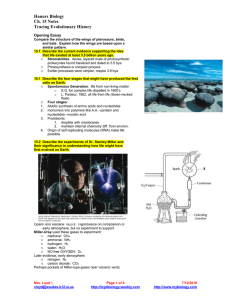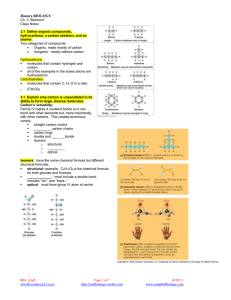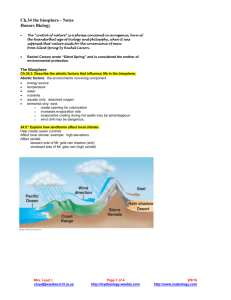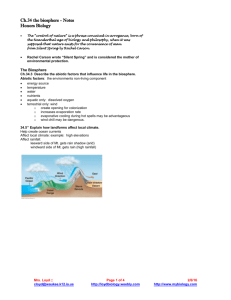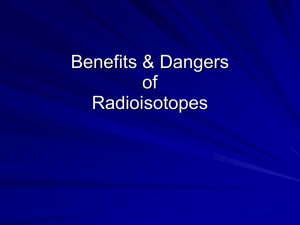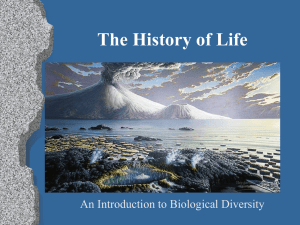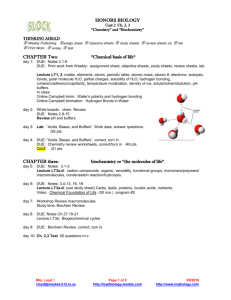File - Mrs. Loyd's Biology
advertisement
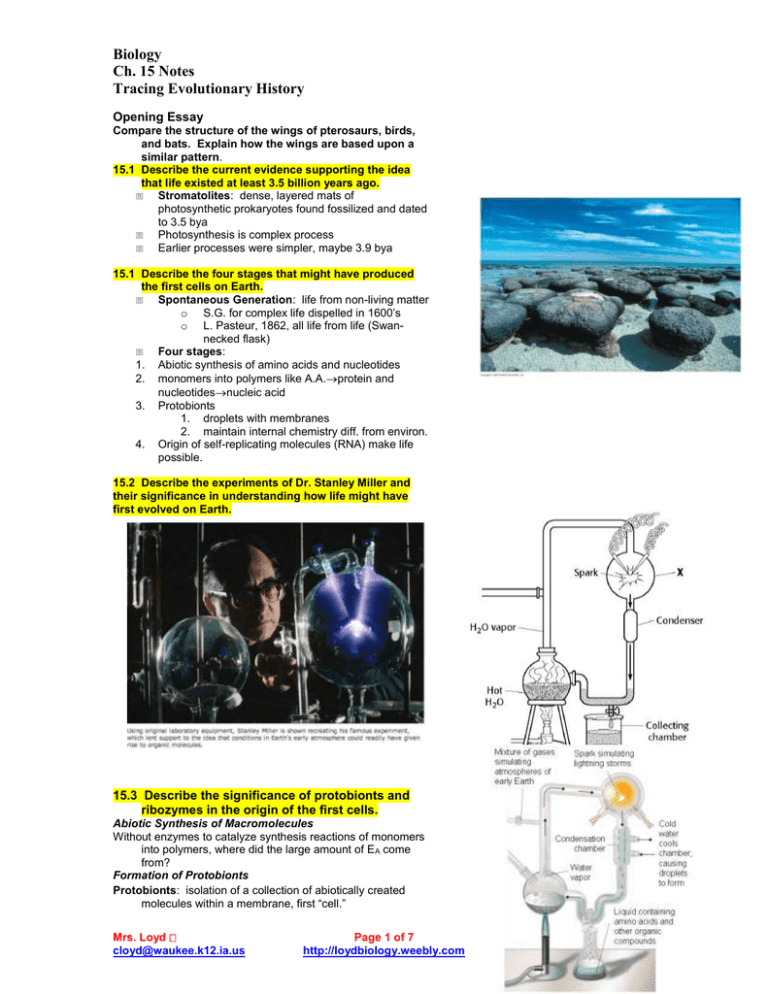
Biology Ch. 15 Notes Tracing Evolutionary History Opening Essay Compare the structure of the wings of pterosaurs, birds, and bats. Explain how the wings are based upon a similar pattern. 15.1 Describe the current evidence supporting the idea that life existed at least 3.5 billion years ago. Stromatolites: dense, layered mats of photosynthetic prokaryotes found fossilized and dated to 3.5 bya Photosynthesis is complex process Earlier processes were simpler, maybe 3.9 bya 15.1 Describe the four stages that might have produced the first cells on Earth. Spontaneous Generation: life from non-living matter o S.G. for complex life dispelled in 1600’s o L. Pasteur, 1862, all life from life (Swannecked flask) Four stages: 1. Abiotic synthesis of amino acids and nucleotides 2. monomers into polymers like A.A.protein and nucleotidesnucleic acid 3. Protobionts 1. droplets with membranes 2. maintain internal chemistry diff. from environ. 4. Origin of self-replicating molecules (RNA) make life possible. 15.2 Describe the experiments of Dr. Stanley Miller and their significance in understanding how life might have first evolved on Earth. 15.3 Describe the significance of protobionts and ribozymes in the origin of the first cells. Abiotic Synthesis of Macromolecules Without enzymes to catalyze synthesis reactions of monomers into polymers, where did the large amount of EA come from? Formation of Protobionts Protobionts: isolation of a collection of abiotically created molecules within a membrane, first “cell.” Mrs. Loyd cloyd@waukee.k12.ia.us Page 1 of 7 http://loydbiology.weebly.com 3/22/2016 http://www.mybiology.com Protobionts or Protocells: Allowed for the concentration of certain combinations of molecules that interact more efficiently. Different environment than surroundings. Abiotically formed lipids: can form small bounded droplets in water Act like phospholipid bilayer Selectively permeable membrane surface Swell or shrink osmotically With enzymes, some can carry out simple metabolic reactions. Self-Replicating RNA: Central Paradigm: DNARNAProtein Evolved slowly, simplecomplex First genes: Self-replicating RNA (assemble spontaneously) First natural selection: RNA molecules that were any better at self-assembly Ribozymes: RNA molecules that are enzyme-like Major Events in the History of Life 15.4 Describe the key events in the history of life on Earth. Origin of Prokaryotes: 3.5 bya2 bya Production of O2. “Oxygen Revolution” o oxidizing rather than reducing atmosphere. o oxidized iron in crustred soil deposits worldwide o poisoned many prokaryotes caused extinction o some survived in anaerobic environments o oxygen-binding as protection may have been first step toward aerobic respiration o allowed these prokaryotes to flourish Origin of Single-celled Eukaryotes: 2.1 bya Originated when small prokaryotic cells capable of aerobic respiration or photosynthesis began living in larger cells Great range of unicellular forms evolved Origin of Multicellular Eukaryotes: 1.5 bya Next wave of diversification descendants include: o algae o plants o fungi o animals Colonization of Land: Required protection from sun o Photosynthesisoxygen rose to upper atmosphere to create ozone protected life from DNA damaging radiation from sun 1 bya Probably began with floating prokaryotic/algal mats 500 mya multicellular eukaryotes encroached on land Plants colonized land in company of fungi *Arthropods o (most diverse and widespread) o insects and spiders Tetrapods Mrs. Loyd cloyd@waukee.k12.ia.us Page 2 of 7 http://loydbiology.weebly.com 3/22/2016 http://www.mybiology.com o o o o four-legged animals includes humans one-hour clock of Earth’s history: H. sapiens appear 0.2 seconds ago 15.5 Distinguish between the relative age and the absolute age of a fossil. Absolute Age: Determining the age of rocks or artifacts using radiometric dating, the rate of decay of unstable isotopes. Relative Age: Indirect way to estimate the age of much older fossils. K-40 (half-life = 1.3 by) used to date volcanic rock layers. The age of fossils found above or below that layer can be estimated relative to the dated rock. Explain how radiometric dating is used to determine the age of rocks and fossils and when carbon-14 and potassium-40 are most appropriately used. C-14 used to date relatively young fossils (75,000 ya) K-40 used to date very old rocks (108 ya or 100’s mya) Knowing both the half-life of a radioactive isotope and the ratio of radioactive to stable isotope in a fossil enables us to tell the age of the fossil. Problems: Show your work, clearly labeled or explain using your best writing skills. 1. Study the graph of the rate of decay of C-14. How long does it take one half of the original amount of C-14 to decay? 2. What is the half-life of C-14? 3. If a sample from an ancient leather hide was found to have .25 grams of C-14 remaining and a modern sample had 1.0 gram of C-14, how old is the ancient hide? 4. If there is 1/8 of the original amount of C-14 remaining, how many half-lives have passed? 5. The ratio between an ancient sample’s amount of C-14 and a modern analog is found to correspond to four halflives of C-14. How old is the sample? 6. A sample was found to have zero C-14 remaining. How old is the sample? Explain. Mrs. Loyd cloyd@waukee.k12.ia.us Page 3 of 7 http://loydbiology.weebly.com 3/22/2016 http://www.mybiology.com Mechanisms of Macroevolution Macroevolution: physical mechanisms: continental drift mass extinction adaptive radiation genetic mechanism: “evo-devo” (genes that control the rate, timing and spatial pattern of changes in an organism’s form as it develops) 15.14 Describe the process of convergent evolution. Timeframe: Post Eukaryotic Multicellularity Supercontinent formed and broke up three times Continental plates move about slowly but incessantly on molten mantel Breakup of Pangaea 180 mya Pangaea started to break apart causing geographic isolation of colossal proportions. Each continent became a separate evolutionary arena Laurasia and Gondwana: 135 mya Radiation in Parallel EXAMPLE: Marsupial/Placental distribution Before breakup Marsupials numerous in Australian area Placentals numerous elsewhere After breakup, Australia: o many placentals became extinct on continent of Australia by competition with more numerous marsupials o Marsupials filled all mammalian niches Elsewhere: o Placentals out-competed marsupials elsewhere o Placental filled all mammalian niches Example: Fossil Lung Fish World-wide distribution indicates that lungfish evolved when Pangaea was intact. Mrs. Loyd cloyd@waukee.k12.ia.us Page 4 of 7 http://loydbiology.weebly.com 3/22/2016 http://www.mybiology.com 15.9 Describe the causes, frequency, and consequences of mass extinctions over the last 600 million years. Mass Extinction: Global environmental changes were so rapid and disruptive that a majority of species were swept away in a relatively short amount of time. Show: NOVA Science NOW, show#7: “Permian Puzzler” (3:30-18:00) CAUSE o o o o o o o o claimed 96% of marine animal species Siberia, enormous volcanic eruptions high CO2 levels global warming reduced temp differences between equator and poles slowed mixing of ocean water reduced O2 available to marine organisms oxygen deficit played large role in P.extinction Cretaceous Extinction: CAUSE o more than half of all marine species o many lineages of terrestrial plants and animals o over just 10 m.y. all dinosaurs (but bird ancestors) gone o Evidence: Iridium in layer of clay worldwide 1 million x higher than normal Iridium is very rare on Earth common in meteorites correlates to end of Cretaceous o hypothesis: fallout from giant meteorite evidence: crater in Yucatan peninsula 180 km wide crater, created by 10 km meteor enough material to create dust cloud that would instantly kill most animals in N. Amer. Consequences Affect biological diversity profoundly Can decimate a thriving and complex ecological community Random events that act on species indiscriminately Can permanently remove species with highly advantageous features Can change the course of evolution forever. Recovery Time? o 5-10 my o Permian: 100 mill. 15.10 Explain how and why adaptive radiations occur. How: Opening up niches due to: o Extinction of species dinosaurs died out mammals radiated into previouslyfilled niches o New territory volcanic islands Galapagos Finches o Adaptations that open new niches bilateral symmetry: predation burrowing muscles: opened ocean bottom stems, waxy covering: opened terrestrial wings: opened skies webs: capture flying prey Why: o Natural selection and the struggle to survive. Mrs. Loyd cloyd@waukee.k12.ia.us Page 5 of 7 http://loydbiology.weebly.com 3/22/2016 http://www.mybiology.com o o o Utilizing a niche with less competition is adaptive. Allows for health and high fecundity. Exponential Growth in new niches. Review: Macroevolution: physical mechanisms: continental drift mass extinction adaptive radiation genetic mechanism: “evo-devo” (genes that control the rate, timing and spatial pattern of changes in an organism’s form as it develops) 15.11 Explain how genes that program development function in the evolution of life. “evo-devo”: scientists working at the interface of evolutionary biology and developmental biology are studying how slight genetic changes can become magnified into major morphological differences between species. Intensity of cause vs. magnitude of effect. Changes in Spatial Pattern: Homeotic genes: o master control genes in development o they determine where appendages will develop. o Changes in such genes or in where these genes are expressed can have a profound impact of body form. Example: Evol. of terrestrial vertebrates from fishes. o Location in developing limb where homeotic gene is expressed is initially the same between the two. o A second region of expression in the developing tetrapod limb, however, produces the extra skeletal elements that develop into foot bones. o Changes in the expression of these genes appear to have led to the evolution of walking legs from the paired fins of fishes. 15.11 Define and describe examples of paedomorphosis. Paedomorphism: retention of juvenile features of ancestors into adulthood. Examples: o Axolotl keep external gills at adulthood instead of lungs. o Humans and chimpanzees are much more alike as fetuses than they are as adults. o Human adult skull is like the fetal skull: rounded skull and small jaw make the face flat and rounded. o Chimpanzee brain after birth shows slow growth while our brain continues to grow at fetal rates for one year. o Both skull and brain show retention of fetal traits. Mrs. Loyd cloyd@waukee.k12.ia.us Page 6 of 7 http://loydbiology.weebly.com 3/22/2016 http://www.mybiology.com 15.12 Define exaptation and describe two examples in birds. Gradual refinement from simpler versions having the same basic function into intricate versions (eyes): Simple ancestral patch of photoreceptor cells Diverged into vertebrate eye and squid eye. Both use same master genes that regulate eye development. Evolved through a series of incremental modifications that benefited their owners at each stage. Gradual adaptation of existing parts to new functions (wings). Exaptations: Structures that evolve in one context but become co-opted for another function. A structure can become adapted to alternative functions. Novel features can arise gradually via a series of intermediate stages, each of which has some function in the organism’s current context. Examples: Evolution of feathers from dinosaurs to birds. First evolved as insulation Mating displays thermoregulation camouflage First flights were mere hops to pursue prey or escape predation. Once flight became an advantage, natural selection would have remodeled feathers and wings to fit their additional function. Penguins are flightless but excellent swimmers wings became “flippers” reduced feathers Phylogeny and the Tree of Life 15.14 Distinguish between homologous and analogous structures and provide examples of each. Homologous structures: due to common ancestry and using “parts available.” Analogous: When natural selection (environment) favors similar adaptations. Creates convergent evolution. 15.14 Describe the process of convergent evolution. see parallel evolution of marsupial and placental mammals. 15.17 Explain how molecular biology is used as a tool in systematics. Molecular Systematics: Comparing nucleic acids or other molecules to infer relatedness. See activity: “Biochemical Evidence” and its summary below. The more recently two species have branched from a common ancestor, the more similar their DNA sequences should be. The longer two species have been on separate evolutionary paths, the more their DNA is expected to have diverged. Mrs. Loyd cloyd@waukee.k12.ia.us Page 7 of 7 http://loydbiology.weebly.com 3/22/2016 http://www.mybiology.com
